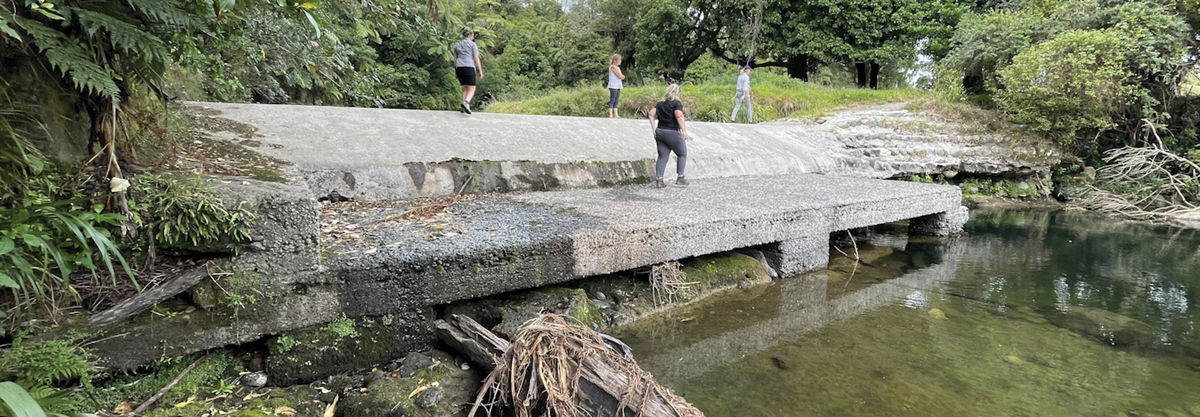
Understanding and fixing obstacles to fish migration
Media release May 19, 2023
An innovative project to understand, identify and remediate barriers to fish migration is taking place in the Taranaki region.
The project is a collaboration between the Department of Conservation (DOC), Fonterra, the Taranaki Regional Council (TRC), and the National Institute of Water and Atmospheric Research (NIWA). Dr Katie Collins, Freshwater Science Lead with Living Water, a partnership between DOC and Fonterra, says the Taranaki region was chosen for the project due to the opportunity to collaborate with a range of agencies and stakeholders and to build on existing work in this area.
‘The Taranaki region has high quality freshwater habitat in the headwaters within the National Park area that DOC administers’, says Dr Collins. ‘TRC have good regional data about instream structures and have identified a number of potential fish barriers that may be restricting fish access to these areas. They’re also working with NIWA to develop a Fish Passage Action Plan for the region. This made Taranaki an obvious choice for a national pilot project.’
The importance of ensuring fish passage, by removing or remediating barriers, is due to New Zealand having many native fish species that undertake migrations as part of their lifecycles, including lamprey/kanakana, whitebait, and eels/tuna. Fish species need to move between freshwater habitats to feed and spawn, and many require access between the sea and freshwater habitats to complete their lifecycles. Instream barriers such as dams, weirs, fords, culverts and tide and flood gates can prevent or delay the movement of fish if they are not designed with fish passage in mind.
Dr Collins says the government has recognised the importance of improving fish passage in new policies and regulations for freshwater under the National Policy Statement for Freshwater Management 2020 (NPS-FM 2020) and the National Environmental Standards for Freshwater.
‘The NPS-FM 2020 requires freshwater to be managed giving effect to Te Mana o Te Wai, prioritising the health and wellbeing of water’, says Dr Collins. ‘For New Zealand’s freshwater to be healthy, fish need to move freely between and within freshwater and marine ecosystems. The NPS-FM 2020 directs regional councils to develop action plans for maintaining or improving fish passage.’
With the legislative framework in place, there is a need to develop targeted information, advice and support for farmers and farm advisors about fish barriers and how to ensure fish passage is provided for on farm. The purpose of the project is to identify priority fish passage barriers on farms and undertake works to remove, replace and/or remediate on-farm structures to facilitate fish passage. As works take place, case studies and supporting “how to” guides can be developed.
Dr Collins says the project will also investigate options to incorporate fish passage remediation into on-farm extension programmes such as Farm Environment Plans prepared for Fonterra farms.
‘Fonterra is supporting TRC to remediate several legacy dairy factory structures in priority locations’, says Dr Collins. ‘Sustainable dairying advisors are also working with individual Fonterra suppliers to develop Farm Environment Plans that assess each farm and identify environmental strengths and opportunities for improvement, which may include fish passage.’
NIWA has recently been contracted by the MfE to assist some regional councils to develop and implement Fish Passage Action Plans (FPAPs) to maintain or improve the passage of fish and the health of native fish populations. Dr Collins says NIWA are using a tool called the Dendritic Connectivity Index (DCI) to measure the extent of fragmentation in each catchment across the country.
‘This tool evaluates each catchment across the country in terms of the barriers to fish migration’, says Dr Collins. ‘The DCI score ranges from 0 (fully fragmented) to 100 (fully connected). The DCI score and other factors, such as invasive species, are being incorporated into a framework to prioritize the removal of barriers that disrupt fish movement across a catchment.’
Dr Collins says the next steps for the Taranaki project will be identifying prioritised on-farm barriers and making contact with potential land-owners.
‘Site visits to scope the work required and identify likely remediation options are essential’, says Dr Collins. ‘Costings and resource consent applications, if they’re required, for remediation will need to be developed before works commence. We’ll also need to conduct fish passage assessments before and after the projects to understand migratory fish movements and how the barriers are impacting fish populations.’
According to DOC, 76% of New Zealand's freshwater fish species are considered threatened or at risk of extinction. Loss of habitat and barriers to migration are contributing factors. It’s hoped that the Taranaki-based project will enable a toolkit of case studies and how to guides that can be used nationally to remediate on farm barriers to fish migration and reverse the decline in native fish species.
